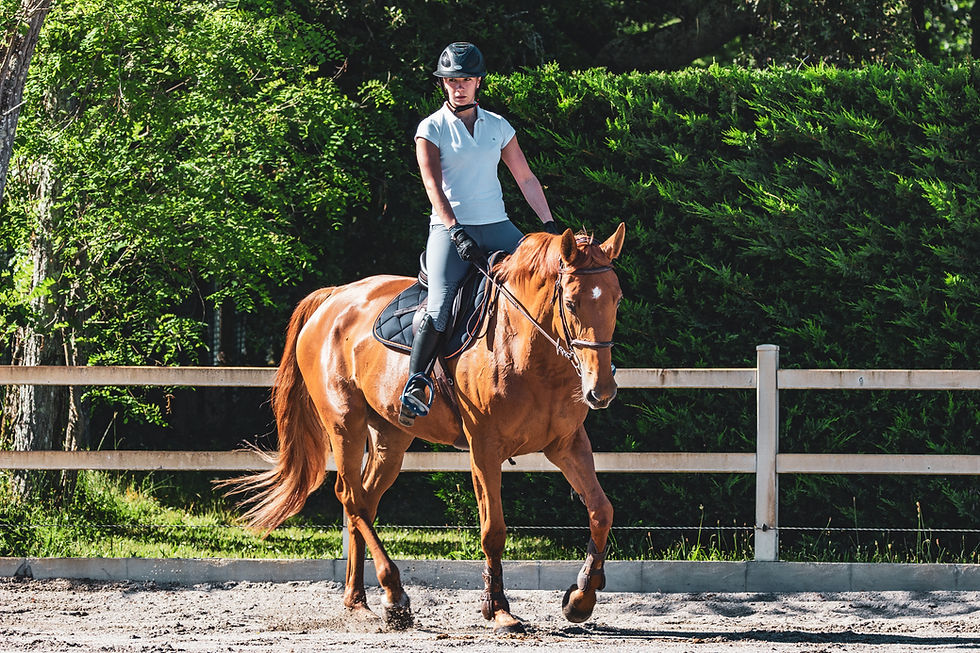Should You Use a Bareback Pad? Here's What the Research Says.
- AHLERI Equine Products

- Jul 2
- 3 min read
Many riders laud the benefits of bareback riding, including avoiding the numerous issues associated with saddle fitting, granting a more direct connection to the horse, and improving the rider's independence and balance. However, research shows that riding without back protection can actually damage the horse! Read the referenced 2012 study in full here.

🐴 1. Should You Use a Bareback Pad? Here's what the 2012 Study Found
A 2013 Michigan State University study measured forces and pressure 🔍 on horse backs when ridden with a conventional saddle versus bareback. Results showed that:
Saddles spread rider weight over a larger area, reducing peak pressure.
Bareback riding—even though total force was lower—created high, focused pressure under the rider’s seat bones.
These pressure points overlapped the horse’s epaxial muscles, raising the risk of soreness or injury.
Simply put: sitting directly on the spine isn’t just uncomfortable—it can produce small but intense pressure points that may lead to muscle damage over time.
🧠 2. Why a Pad or Saddle Matters
⚖️ Distributing Weight
Saddles have a rigid tree or frame that helps spread the rider’s weight evenly over the horse’s back.
Bareback pads, while typically lacking a tree, add cushioning and prevent direct bone‑to‑back contact.
🚫 Reducing Pressure Points
With bareback alone, your ischial tuberosities (seat bones) concentrate pressure on small spots.
The study noted higher maximal pressures and more areas above 11 kPa with bareback riding.
A nice thick pad, like the QHP Super Soft Bareback Pad, softens these focal pressures; a saddle redistributes them, as long as it fits.
🆚 3. Pads vs. Saddles – What’s the Difference?
Feature | Bareback Pad | Saddle (Treed or Treeless) |
Structure | Soft cushioning, no rigid frame | Tree/form redistributes weight evenly |
Pressure distribution | Reduces peak spots vs fully bareback, but limited | Broad surface area, lower peak pressure |
Balance support | Slight help, may still slip or twist | Structured seat supports rider balance |
Risk factors | Slippage, twisting (especially with stirrups) | Saddle fit still critical |
A bareback pad offers comfort, but doesn't distribute weight. Without added stirrups, they are generally more comfortable for the horse and safer to the rider.
Saddles provide better stability and weight distribution, but must fit the horse’s spine, withers, and back properly.
Choosing the right option will depend on how confident you are in your saddle fit!
🕐 4. When It’s Safe or Risky

Safe Scenarios:
Short, infrequent rides (walk/canter), on a well‑muscled horse.
Using a high‑quality pad (e.g. QHP, Barefoot, ThinLine) that contours to the back and lifts off the spine.
Riders with good balance.
Risk-Causing Scenarios:
Rider lacks balance, or uses stirrups on a pad—can twist or dig in.
Long rides or frequent sessions—pressure builds over time.
Weak‑backed, older horses, or those with spinal issues (e.g. swayback, kissing spine).
Bareback riding without a saddle or pad may “leave pressure points… cause muscle strain” especially in larger or longer rides.
✅ 6. Smart Recommendations
Choose a quality bareback pad: thick fleece, non‑slip, contoured to the horse's back, spinal freedom.
Use stirrups only with appropriate tack: stirrups on bareback pads can concentrate pressure on the horse's spine.
Ride short sessions: 15–30 min max if riding bareback—even with a pad.
Prioritize a good saddle fit: even the best pad can’t fix a poorly‑fitting saddle.
Monitor your horse: check for soreness, muscle tightness, or behavior changes.
Strength train your horse: a muscular topline helps absorb rider weight.
🌟 7. Benefits Recap
Using a bareback pad or properly‑fitted saddle helps you:
Protect your horse's muscles and spine from damage.
Distribute your weight more evenly.
Maintain better balance and stability while riding.
Prevent soreness, swelling, or long‑term injury.
Bareback riding can improve your connection and feel for your horse—but only when done responsibly and with proper protection.

📌 Final Takeaway
Riding directly bareback may feel freeing, but it puts concentrated pressure on your horse’s back, risking soreness and injury. A thick bareback pad, or a well-fitted saddle with a rigid tree, dramatically reduces pressure hotspots and gives stability. For occasional, short rides, quality pads can work—but for regular schooling or long rides, choose a saddle that fits both you and your horse.
Taking these small steps ensures riding remains enjoyable and safe for both you and your equine partner.
_edited.png)
_edited.png)
.png)







Comments